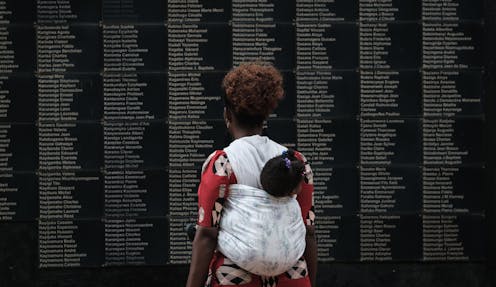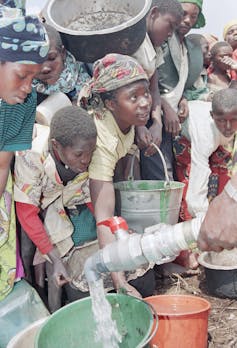Rwandan genocide, 30 years on: Omitting women’s memories encourages incomplete understanding of viol
Rwanda is touted as one of the leading nations when it comes to strides toward gender equality. But the role of female ‘rescuers’ in the 1994 genocide is being downplayed.

The eruption of violence that Rwanda experienced beginning on the evening of April 6, 1994, continues to haunt the central African nation 30 years on – it has also changed the country’s gender dynamics.
The genocide resulted in hundreds of thousands of men being killed, with many more fleeing the country or being incarcerated. It left a previously male-centered society with hundreds of thousands of female-headed households. Of course, women were also subjected to the violence itself, with many killed and between 250,000 and 500,000 raped in the three months of genocide.
The scale of violence and disruption to Rwandan society created a need to systematically restructure the country. This was achieved, in part, by setting a quota for 30% of Parliament to be made up of women.
In the years since the genocide, Rwanda has been touted as one of the most gender egalitarian countries in the world, with women making up 61.3% of the nation’s parliament today. Likewise, after the genocide, the nation restructured many of its laws to be more equitable, allowing women to own and inherit land and open bank accounts. Legislation was also put in place to prohibit workplace gender discrimination.
However, despite these accomplishments toward gender equality, women have not necessarily achieved equal status. Women still experience high rates of domestic violence, low employment rates and low educational attainment compared with Rwandan men.
And, as my research shows, women have been largely omitted from the narratives and collective memories of the genocide. I analyzed the interviews of 175 “rescuers” – the term used for people who hid or protected those hunted during the genocide – and found that women’s recollections of the violence were being excluded at disproportionately higher rates than those of men. The interviews were originally conducted by Hollie Nyseth Nzitatira and Nicole Fox, two of the leading researchers on the aftermath of genocide in Rwanda.
Incomplete narratives
Omitting women’s voices in the process of remembering the violence in Rwanda will, I believe, further a narrative of the genocide that is at best incomplete and at worst misleading.
Already, there is criticism over the way that a single narrative has been adopted that lacks nuance. The atrocity is often framed as the natural culmination of two historically feuding ethnic groups, the Hutus and Tutsis, who vied for political power, with the Hutus eventually committing a genocide against the Tutsis.
However, this is an incomplete version of both Rwanda’s history as well as the genocide. Prior to colonization in 1919, Hutus and Tutsi were impermanent economic class categories, likely determined by the number of cattle individuals owned. The ethnicization of the categories was then arbitrarily created by the colonial power, Belgium, in 1935 and remained in place when Rwanda was decolonized in 1962.

The common narrative that during the genocide the Hutus killed the Tutsis is also only a portion of the story. Many moderate Hutus were killed because of their refusal to participate in the violence. Twa, a third ethnic group, were also targeted and killed, while other Hutus chose to rescue Tutsis from violence.
Today the Rwandan government accepts only the narrative of Tutsis being targeted by Hutus, with the official title of the genocide being the “1994 Rwandan Genocide Against the Tutsi.”
Downplaying the role of women
Recent academic work has pointed toward criticism of how Rwanda’s national narrative of the genocide has created a hierarchy of victimhood in which only Tutsis’ victimhood is acknowledged.
Memorials, monuments and textbooks are some of the ways in which collective memories are formed after war, conflict and natural disasters.
Rwanda is unique, however, in that the country facilitates collective memories during annual commemoration events held in local communities. At these commemorations, survivors, rescuers and perpetrators of the violence publicly share their testimonies.
Similar to how the Rwandan government considers only Tutsis to be the victims of the genocide, it also has a narrow definition of “rescuers.” Rescuers are defined by the Rwandan government as individuals who protected or evacuated Tutsis, or made other efforts to save them, and who did not participate in the genocide whether by killing, raping, destroying property or looting.
Rescuers are some of the most frequent speakers at formal commemoration events. By giving a platform to people who were willing to risk their lives to protect their fellow citizens, the government hopes to promote national unity.
But my research has found that male rescuers have a higher profile and more options to tell their story, compared with their female counterparts.
The people asked to testify at formal commemoration events are chosen by local leaders and are not always a representative sample. Women are often not asked to testify, as they are deemed too emotional. Likewise, individuals who are selected to testify often have their stories vetted to ensure their narrative aligns with that of the Rwandan governments.
I analyzed interviews with 175 rescuers – 113 men and 62 women. Of those, 50 people – 23 men and 27 women – had not yet shared their story at a formal commemoration event.
When the 50 individuals who had not shared their story at commemoration were asked why they had not yet done so, and whether they felt they would be asked to testify in the future, two clearly gendered responses emerged.
The women in the sample expressed two reasons for having not yet testified: 10 said that their husbands always testified instead of them, and another seven stated that they had never been asked. Those who had never been asked to testify likewise expressed no hope that they would be asked to testify in the future and had not found alternative ways of sharing their stories.
Meanwhile, just six men stated that they had not been asked to speak at a formal commemoration event. However, all six men said that they had already found other ways of sharing their stories, such as through working with a local NGO or speaking to schoolchildren about the genocide.
Witnesses to violence
Commemoration events are far from the only times in which women’s voices have been omitted from the genocide.
Women’s names have been left off formal lists of rescuers, and their unique rescue contributions have largely been ignored.
Meanwhile, women who participated in the violence have been dismissed as monsters. This has resulted in a disparity in how women are able to recover after the genocide compared with men who participated. It also largely erases conversations around why women may have chosen to participate in the violence.
Likewise, female victims of the genocide have been primarily framed as victims of rape or helpless widows. Focusing on women as victims risks ignoring their other experiences.
Including more women’s voices – and a more nuanced discussion of women’s experiences during mass violence – is vital to understanding how the collective memory of the Rwandan genocide is being constructed, and in flagging concerns around gender disparities in who is permitted to help construct such memories.
Anneliese M. Schenk-Day does not work for, consult, own shares in or receive funding from any company or organization that would benefit from this article, and has disclosed no relevant affiliations beyond their academic appointment.
Read These Next
Data centers need electricity fast, but utilities need years to build power plants – who should pay?
How many data centers will be built – and how much electricity they’ll need – is uncertain. Being…
Sleep problems and depression can be a vicious cycle, especially during pregnancy − here’s why it’s
Inadequate sleep can have negative downstream effects on everyday cognitive functioning and mental health,…
How a niche Catholic approach to infertility treatment became a new talking point for MAHA conservat
Mainstream medical organizations have criticized ‘restorative reproductive medicine,’ but some Catholics…






